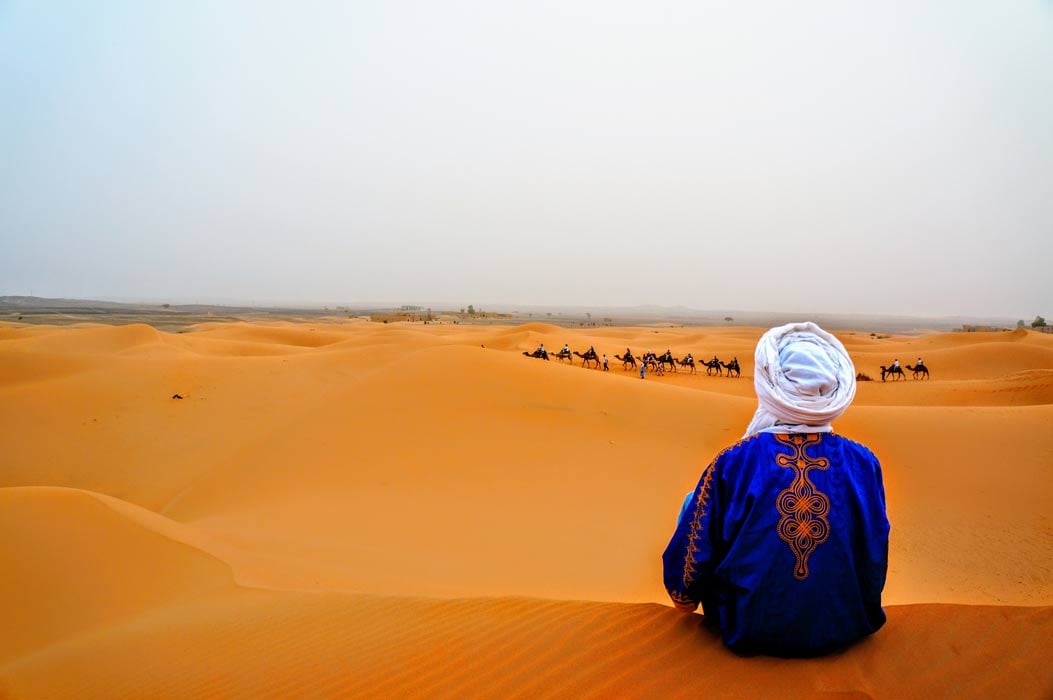The Rich Mythology and Megalithic Culture of the Ancient Berbers, Lords of the Desert
The Barbary Coast of North Africa was named after the Berbers, the nomadic people who inhabited the region west of the Nile Valley in north Africa. Called the Amazigh or Imazighen in antiquity (meaning "free humans" or "free men"), they are among the oldest inhabitants of North Africa. Their rich mythology endured for thousands of years, eventually coming to influence the religious beliefs of the ancient Egyptians.
The history of the Berber people in northern Africa is extensive and diverse. The Berbers are a large group of non-Arabic tribes related by language and culture and inhabiting areas stretching from Egypt to the Canary Islands as well as regions south of the Sahara, such as Niger and Mali. Archaeologists have traced their origins to the Caspian culture, a North African civilization that dates back more than 10,000 years. Berber-speaking people have lived in North Africa since the earliest times and are first referenced by the Egyptians in 3,000 BC under the name Temehu. Phoenician, Greek, and Roman texts also refer to them.

An Egyptian statuette representing a vanquished Libyan Libu Berber. Reign of Rameses II (19th Dynasty), 1279–1213 BC. (Louvre Museum, Paris). (Guillaume Blanchard/CC BY SA 3.0)
A Crossroad of Berber People
Since prehistoric times, Berber lands have been a crossroad of peoples from Africa, Europe, and the Middle East. The Carthaginians, Romans, Vandals, Byzantines, Arabs, Turks, Spaniards, French, and Italians have invaded and ruled portions of the Berber homeland. However, the Berbers have never experienced a unified political identity. There have been many Berber kingdoms and cultures existing alongside one another in various regions of North Africa and Spain, but never a unified "Berber empire".
- The Ancient Tuaregs, Lost Lords of the Sahara
- 13,000-year-old Saharan remains may be evidence of first known race war
- Nabta Playa and the Ancient Astronomers of the Nubian Desert
Throughout the centuries, Berbers have mixed with many ethnic groups, including Arabs, and because of this, they have come to be identified more by linguistics instead race. Their language is one of the oldest in the world and belongs to the African branch of the Afro-Asian language family, along with ancient Egyptian.

A beautiful young Berber woman of Tunisia, with tattoo and traditional jewelry (early 1900s). Photo by Rudolf Lehnert. (Public Domain)
Berber Mythology
Although never formalized beyond local cults, the Berbers had a rich mythology and belief system structured around a pantheon of gods. Many of their beliefs were developed locally while some were imported or later influenced by contact with other African mythologies, such as the Egyptian religion, along with Phoenician mythology, Judaism, Iberian mythology, and the Hellenistic religion during antiquity.
The most recent influence came from Arab mythology, when the Berbers were converted to Islam during the ninth century. Today, some of the traditional, ancient, pagan Berber beliefs still exist within the culture and tradition, especially in Algeria, where older cults still survive to varying extents.

Tariq ibn Ziyad, Berber Muslim and Umayyad general who led the conquest of Visigothic Hispania in 711. (Public Domain)
Many prehistoric peoples considered rocks to be holy, including the Berbers. Second century Latin writer Apuleius, along with Saint Augustine, bishop of the Hippo Regius (the ancient name of the modern city of Annaba, in Algeria), both remarked on rock-worship among North Africans. The Greek historian Herodotus also wrote of their ancient sacrificial practices:
They begin with the ear of the victim, which they cut off and throw over their house: this done, they kill the animal by twisting the neck. They sacrifice to the Sun and Moon, but not to any other god.
The Megalithic Culture of the Berbers
The megalithic aspect of the Berber culture may have been used as a cult of the dead and/or star-worship. The best known rock monument in Northwest Africa is Mzora (or Msoura). It is composed of a circle of megaliths surrounding a tumulus. The current site of 168 remaining stones first became known in the west in 1830 AD, thousands of years after it was constructed. The tallest megalith measures more than 5 meters (16 feet) in height. According to legend, it is the resting place of the mythical Berber king, Antaeus. He was a legendary giant who was slayed by the heroic demi-god Hercules as one of his labors.
Another megalithic monument connected to the Berbers was discovered in 1926 south of Casablanca and was engraved with funerary inscriptions in the Libyco-Berber script known as Tifinagh.

Sketch of Mzora Stone Circle, 1830 The Mysterious Moroccan Megalithic Menhirs of Mzora. (Public Domain )
The tombs of the early Berbers and their ancestors (the Caspian’s and Ibero-Mauresians) indicate that they believed in the afterlife. The prehistoric men of the region of northwest Africa buried their bodies in the ground. Later, they buried the dead in caves, tumuli (burial mounds), and tombs cut into rock. These tombs evolved from primitive structures to more elaborate ones, such as the pyramidal tombs that spread throughout North Africa.
The best known Berber pyramids are the 19 meter (62 ft) pre-Roman Numidian pyramid of Medracen and the 30-meter (98 ft) tall ancient Mauritanian pyramid located in modern-day Algeria. Also known as the Royal Mausoleum of Mauretania, the mausoleum is believed to have been the final resting place for Berber King Juba II and Queen Cleopatra Selene II, the rulers of Numidia and Mauretania. However, no human remains have been located at the site, leading some scholars to suggest the tomb was probably looted at some point.

Numidian pyramid of Medracen. (Reda Kerbush/CC BY SA 3.0)
Influencing Worship of Egyptian Gods
Among ancient Berber and Egyptian mythology there are similar and overlapping deities. The Berbers were neighbors of the Egyptians, originally inhabiting the lands of Libya for thousands of years before the beginning of human records in ancient Egypt. It is thought that some ancient Egyptian deities, such as Isis and Set, were originally worshipped by the Berbers.
Osiris was one of the Egyptian deities’ paid homage to in Libya and some scholars believe Osiris was originally a Libyan god. Berbers supposedly did not eat swine flesh because it was associated with Set and they did not eat cow flesh, because it was associated with Isis. This was reported by Herodotus:
Cow's flesh, however, none of these [Libyan] tribes ever taste, but abstain from it for the same reason as the Egyptians, neither do they any of them breed swine. Even at Cyrene, the women think it wrong to eat the flesh of the cow, honoring in this Isis, the Egyptian goddess, whom they worship both with fasts and festivals. The Barcaean women abstain, not from cow's flesh only, but also from the flesh of swine
Another one of their deities the Egyptians worshipped but considered to have a Libyan origin was Neith, who is said to have emigrated from Libya to establish her temple at Sais in the Nile Delta. Some legends say that Neith was born around Lake Tritons or modern Tunisia. It is notable that some Egyptian deities were depicted with Berber (ancient Libyan) characters, such as "Ament" - who was depicted with two feathers, which were the normal ornaments of the ancient Libyans as shown by the ancient Egyptians.

Aegis of Neith from the Late Period, Twenty-sixth dynasty (ca. 664-525 BC) golden bronze, Museum of Fine Arts of Lyon. (Rama/CC BY SA 2.0)
The most remarkable common god between Egyptian and Berber culture was Amon. King of the gods and god of the wind, he was adopted by the ancient Egyptians as Amen-Ra, by the Greeks as Zeus-Amon, and by the Phoenicians as Baal-Amon.
Represented in human form, sometimes with a ram’s head, early depictions of rams have been found across North Africa dating to 9600 BC and 7500 BC. The most famous temple of Ammon in Ancient Libya was the augural temple at Siwa in Egypt, an oasis still inhabited by the Berbers. Although most modern sources ignore the existence of Ammon in Berber mythology, he was honored by the ancient Greeks in Cyrenaica, and was united with the Phoenician god Baal due to Libyan influence.
- Two Ancient High Official Father and Son Tombs Opened at Pyramids Area in Egypt
- Remains of 1,500-year-old monastery with spectacular mosaics uncovered in Negev Desert
- The Ancient, Fortified Ksar of Ait-Ben-Haddou Awaits the Return of Desert Traders
Embracing Berber Culture
While much of the Berber culture has been suppressed over the years, in Tunisia it is seeing a revival . Ever since the 2011 ousting of dictator Zine El Abidine Ben Ali, who had enforced decades of language and cultural suppression in his pursuit of a united nation, interest in Berber culture has reemerged. Today, there are now more than 20 organizations actively promoting Berber culture and heritage.

Berber musicians. (kippis /Adobe)
Top Image: The Berbers are often called the lords of the desert. Source: 沖 上田 /Adobe
References
"LookLex Encyclopedia." Berber Religion. http://i-cias.com/e.o/berber.religion.htm
"Amazigh, (Berber) the Indigenous Non-Arab Population of North Africa, and Their Language." Phoenicia. http://phoenicia.org/berber.html
"Berber People." Africa Guide. http://www.africaguide.com/culture/tribes/berber.htm
"Ancient Scripts: Berber." Ancient Scripts. http://www.ancientscripts.com/berber.html
Thompson, Irene. "Berber Branch." About World Languages. 2013. http://aboutworldlanguages.com/berber-branch
"Berbers: The Empire without Borders." Berbers (Imazighen) of North Africa: Libya, Algeria & Morocco. https://www.temehu.com/imazighen/berbers.htm
"The Berbers - Ancient Atlantis." Ancient Atlantis. April 15, 2014. http://www.ancient-atlantis.com/the-berbers/


















Comments
Berbers have always call themselves (imazighen) which means (free Men) and they refer to their language as (Tamazight). The name (Berbers) was given to them by Romans.
Hilariously the Berbers though not typically on the best of terms with the Egyptians, asked for their help when the Greeks invaded North Africa, according to Herodotus the Greek army destroyed the assistance provided by Egyptians so that, "none were able to return"
I believe that you mean to refer to the Capsian culture (named for the Tunisian town of Gafsa, known as Capsa during the Roman period) rather than "Caspian", which would tend to indicate an Iranian origin.
Man I want to say something. Not everything what you see is true. They didn't worship ore secrefice for the moon ore for the sun. They did it oly in that time. It was a form of respect. They never worshipped gods beside Allah. They only believe in spirits. That you know as the Jinns and Angels. It was a moon spirit and a sun spirit. they show them respect but they dodn't worship it. And many places we are thinking that they are worshipping gods. it is not true. They only believe and respect the spirits they know. some are worshipping it but that is wrong dooing. Butthe hindus they believe in One devine. located in three persons. And that everything els are spirits they are worshipping idols that is true. but they take that statue witch they ask the somethings that reminds the statues. The statues is a way to pray to God. The forms give them a sign to God. They know that they will not see God that is whay they are painting him ore do a statue of that. But i know that is wrong dooing and permisseble.
Pretty disappointed that it wasn't mentioned that the "mausoleum of Numidian kings" is the tomb and resting place of queen cleopatra Selene And King Juba.